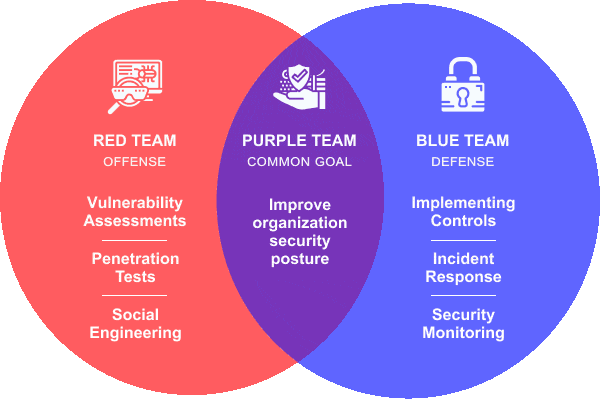Red Team – test your incident response
FAQ
A Red Team is a group of security professionals who simulate attacks on an organization's security infrastructure to identify vulnerabilities and weaknesses. Their goal is to find flaws in an organization's defenses that could be exploited by real attackers. They employ tactics similar to those used by actual hackers, including social engineering, phishing, and other attack methods. After the simulation, the Red Team provides recommendations to the organization on how to improve their security posture and prevent future attacks.
The duration of a Red Teaming operation can vary significantly depending on several factors:
- Scope and complexity of the project
- Objectives of the operation
- Available resources and budget
Operations can range from a few days to several weeks or even months. They typically involve multiple phases:
- Reconnaissance
- Planning
- Execution
- Reporting
The duration of each phase may vary based on the project's specific requirements.
Penetration Testing (Pen Testing)
- Conducted by a "white team"
- Focuses on identifying and exploiting specific vulnerabilities
- Aims to provide recommendations on fixing identified vulnerabilities
Red Teaming
- More comprehensive approach
- Simulates real-world attacks on an organization's entire security infrastructure
- Uses tactics similar to actual attackers
- Aims to identify weaknesses in the overall security posture
- Provides broader recommendations for improving overall security
In summary, pen testing is more focused on specific vulnerabilities, while Red Teaming assesses the organization's overall security effectiveness.
A Red Team operation could potentially cause damage or disruption if not properly planned and executed. Since it simulates real-world attacks, the team may attempt to exploit vulnerabilities in the organization's security infrastructure. Without careful planning and execution, their actions could inadvertently disrupt systems or operations. It's crucial that Red Team operations are meticulously planned and conducted with the organization's specific goals and objectives in mind, balancing realism with safety.
Incident Response Process
- Preparation: Develop an incident response plan and train relevant personnel.
- Identification: Detect and confirm the incident through monitoring.
- Containment: Isolate affected systems to prevent further damage.
- Analysis: Gather and analyze evidence to determine the incident's scope and nature.
- Eradication: Remove the incident source and associated malicious elements.
- Recovery: Restore systems and data to a secure state.
- Post-incident activities: Review, learn, and improve security measures.
- Identify and contain the incident: Isolate affected systems or disable network services.
- Assess the impact: Gather information about the incident type, affected systems, and potential damage.
- Notify stakeholders: Inform management, IT staff, and potentially affected customers or clients.
- Investigate the incident: Determine the cause and identify exploited vulnerabilities.
- Remediate the incident: Address vulnerabilities and implement preventive measures.
- Review and improve: Analyze the response process, update policies and procedures, enhance security controls, and provide additional staff training as needed.

